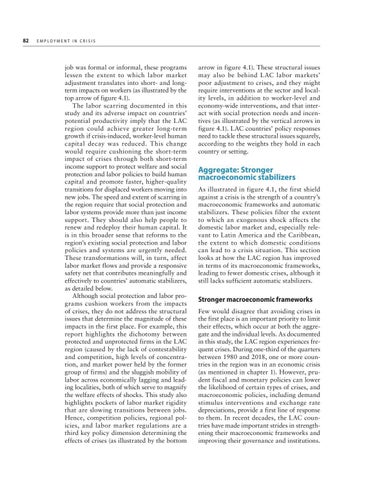82 E m p l o y m e n t
in Crisis
job was formal or informal, these programs lessen the extent to which labor market adjustment translates into short- and longterm impacts on workers (as illustrated by the top arrow of figure 4.1). The labor scarring documented in this study and its adverse impact on countries’ potential productivity imply that the LAC region could achieve greater long-term growth if crisis-induced, worker-level human capital decay was reduced. This change would require cushioning the short-term impact of crises through both short-term income support to protect welfare and social protection and labor policies to build human capital and promote faster, higher-quality transitions for displaced workers moving into new jobs. The speed and extent of scarring in the region require that social protection and labor systems provide more than just income support. They should also help people to renew and redeploy their human capital. It is in this broader sense that reforms to the region’s existing social protection and labor policies and systems are urgently needed. These transformations will, in turn, affect labor market flows and provide a responsive safety net that contributes meaningfully and effectively to countries’ automatic stabilizers, as detailed below. Although social protection and labor programs cushion workers from the impacts of crises, they do not address the structural issues that determine the magnitude of these impacts in the first place. For example, this report highlights the dichotomy between protected and unprotected firms in the LAC region (caused by the lack of contestability and competition, high levels of concentration, and market power held by the former group of firms) and the sluggish mobility of labor across economically lagging and leading localities, both of which serve to magnify the welfare effects of shocks. This study also highlights pockets of labor market rigidity that are slowing transitions between jobs. Hence, competition policies, regional policies, and labor market regulations are a third key policy dimension determining the effects of crises (as illustrated by the bottom
arrow in figure 4.1). These structural issues may also be behind LAC labor markets’ poor adjustment to crises, and they might require interventions at the sector and locality levels, in addition to worker-level and economy-wide interventions, and that interact with social protection needs and incentives (as illustrated by the vertical arrows in figure 4.1). LAC countries’ policy responses need to tackle these structural issues squarely, according to the weights they hold in each country or setting.
Aggregate: Stronger macroeconomic stabilizers As illustrated in figure 4.1, the first shield against a crisis is the strength of a country’s macroeconomic frameworks and automatic stabilizers. These policies filter the extent to which an exogenous shock affects the domestic labor market and, especially relevant to Latin America and the Caribbean, the extent to which domestic conditions can lead to a crisis situation. This section looks at how the LAC region has improved in terms of its macroeconomic frameworks, leading to fewer domestic crises, although it still lacks sufficient automatic stabilizers.
Stronger macroeconomic frameworks Few would disagree that avoiding crises in the first place is an important priority to limit their effects, which occur at both the aggregate and the individual levels. As documented in this study, the LAC region experiences frequent crises. During one-third of the quarters between 1980 and 2018, one or more countries in the region was in an economic crisis (as mentioned in chapter 1). However, prudent fiscal and monetary policies can lower the likelihood of certain types of crises, and macroeconomic policies, including demand stimulus interventions and exchange rate depreciations, provide a first line of response to them. In recent decades, the LAC countries have made important strides in strengthening their macroeconomic frameworks and improving their governance and institutions.

